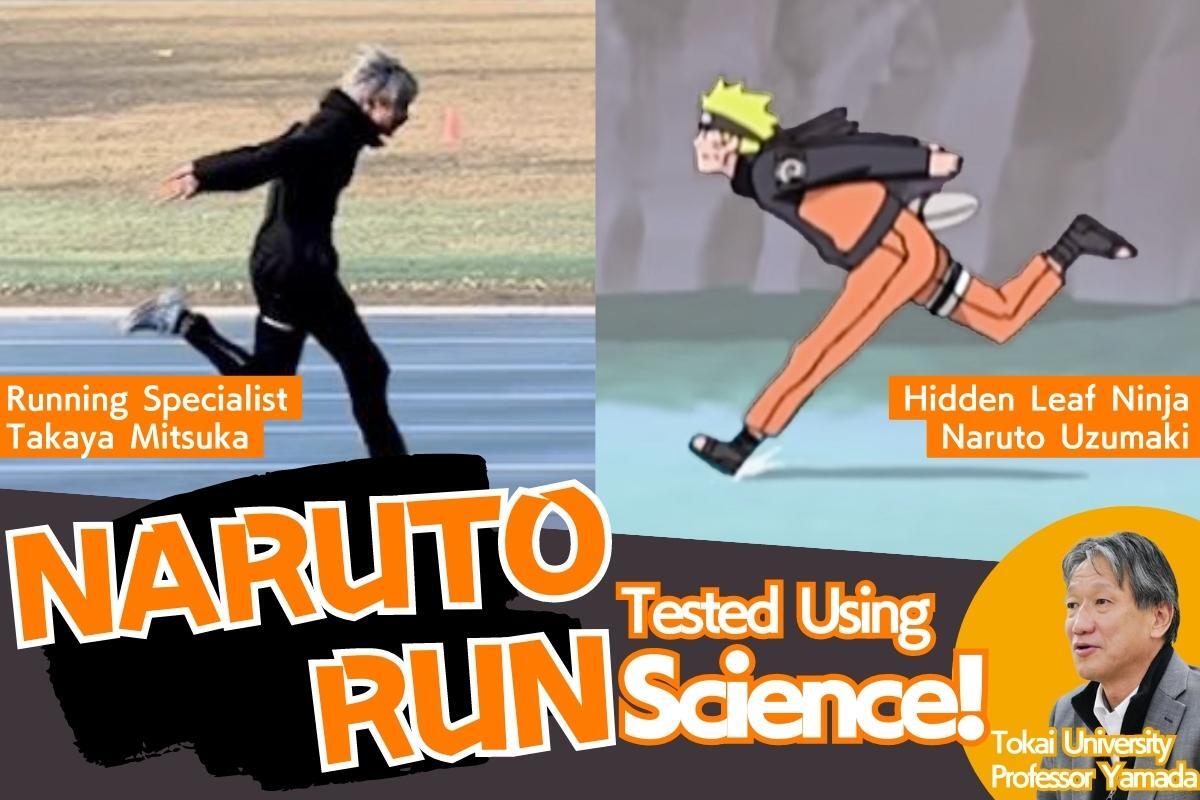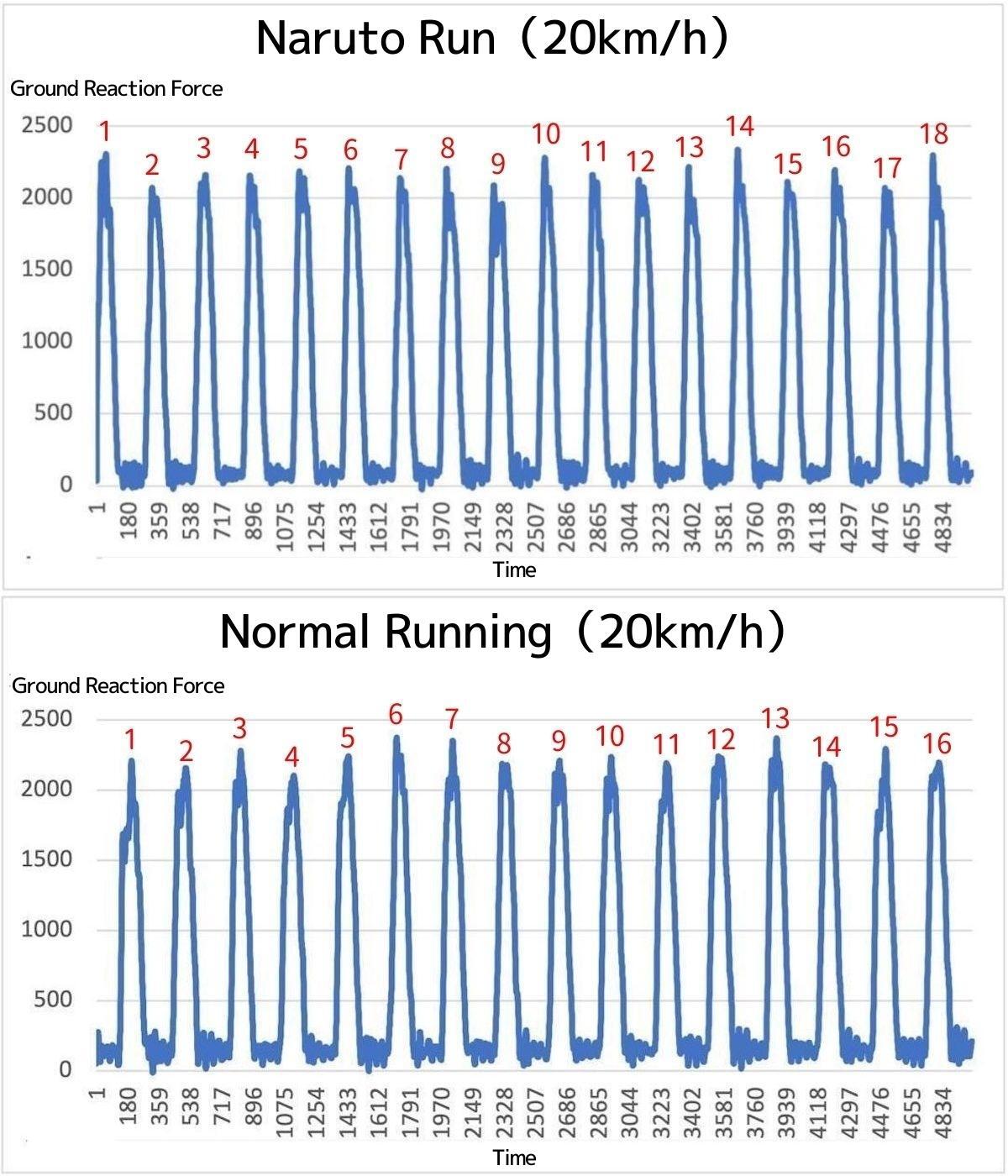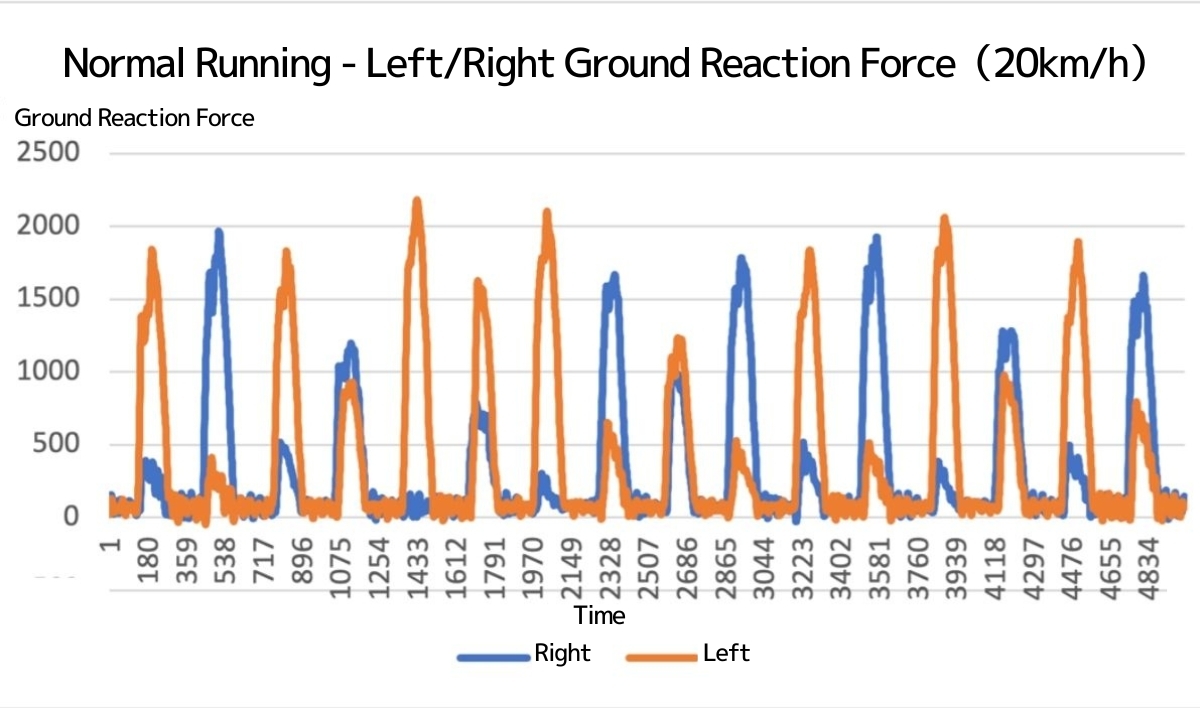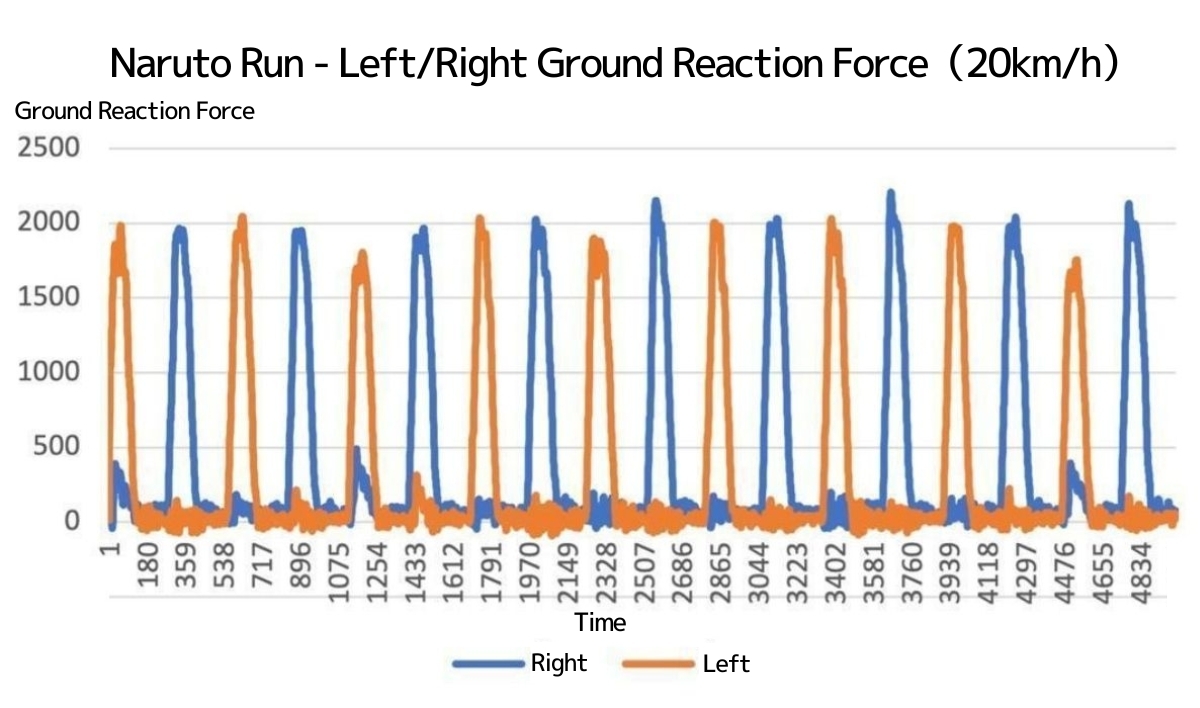
Naruto Columns
06/08/2023
Professional Runner Takaya Mitsuka Sprints 50 Meters Using the "Naruto Run", Aiming for Speed Shinobi Style!

The "Naruto Run" is a name given by fans to the unique running style utilized by characters in the NARUTO series.
It's a peculiar-looking technique where the runner leans their upper body forward and stretches both arms out behind them in a way that somewhat resembles an airplane. The sense of speed this look creates is certainly cool.
However, it's not exactly compatible with conventional running theory, which emphasizes making use of the force generated by swinging one's arms.
Is it even possible to run fast without swinging your arms?
Won't running while leaning forward just make you fall over?
Are there any advantages to running this way at all?
To answer these questions, we enlisted the help of some experts for an experiment.
Let's combine the power of sports science theory with real-life tests carried out by a professional athlete to thoroughly dissect the Naruto Run!
However, it's not exactly compatible with conventional running theory, which emphasizes making use of the force generated by swinging one's arms.
Is it even possible to run fast without swinging your arms?
Won't running while leaning forward just make you fall over?
Are there any advantages to running this way at all?
To answer these questions, we enlisted the help of some experts for an experiment.
Let's combine the power of sports science theory with real-life tests carried out by a professional athlete to thoroughly dissect the Naruto Run!
The Man Who Ran 50 Meters in 6 Seconds Using the Naruto Run
For our experiment, we invited running coach and model Takaya Mitsuka.

On his YouTube channel, Mr. Mitsuka challenged himself in the video 「ナルト走りでも50m走6秒台出せる説」 (Is it possible to run 50m in 6s using the Naruto Run?) and achieved a time of 6.95 seconds. He may very well be the current record holder for the Naruto Run.
The Merits of the Naruto Run According to a Sports Science Expert
This time, alongside Mr. Mitsuka, we wanted to incorporate sports science as part of a two-step approach.
With this in mind, we looked to Tokai University, which has produced a number of top sprinters such as Naoki Tsukahara and Shingo Suetsugu. We hoped to use the university's cutting-edge equipment to analyze the mechanics of the Naruto Run.
Then, to measure the actual speed of the running style, we would have Mr. Mitsuka sprint using both the Naruto Run and his regular form, and compare the times against each other.
With our plan decided, we arrived at Tokai University's School of Physical Education and met the man who would be supervising our test, Professor Hiroshi Yamada.
With this in mind, we looked to Tokai University, which has produced a number of top sprinters such as Naoki Tsukahara and Shingo Suetsugu. We hoped to use the university's cutting-edge equipment to analyze the mechanics of the Naruto Run.
Then, to measure the actual speed of the running style, we would have Mr. Mitsuka sprint using both the Naruto Run and his regular form, and compare the times against each other.
With our plan decided, we arrived at Tokai University's School of Physical Education and met the man who would be supervising our test, Professor Hiroshi Yamada.

Dr. Yamada's field of "sports biomechanics" is all about understanding the relationship between movement and force in sports. This understanding allows athletes to further improve their techniques.
We asked Dr. Yamada to give us his honest opinion on the Naruto Run. What does an expert have to say about this bizarre running style?
—Thank you for agreeing to meet with us, Dr. Yamada. First off, were you previously aware of the Naruto Run?
Dr. Yamada: I knew to some degree that styles like it existed. In fact, I've actually seen some of my students run like that during PE classes.
This is just one example, but during basketball practice a student once used that style when chasing after a rebound.
That said, I had no idea that it had anything to do with NARUTO, so reading your proposal this time piqued my interest.
We asked Dr. Yamada to give us his honest opinion on the Naruto Run. What does an expert have to say about this bizarre running style?
—Thank you for agreeing to meet with us, Dr. Yamada. First off, were you previously aware of the Naruto Run?
Dr. Yamada: I knew to some degree that styles like it existed. In fact, I've actually seen some of my students run like that during PE classes.
This is just one example, but during basketball practice a student once used that style when chasing after a rebound.
That said, I had no idea that it had anything to do with NARUTO, so reading your proposal this time piqued my interest.

—In your opinion, is the Naruto Run an effective running form?
Dr. Yamada: That's a difficult question to answer, but at the very least I can say that it runs counter to conventional wisdom in athletics. The traditional running style, where the upper body is kept upright and the arms swung, is the logical choice when sprinting.
However, one thing does stick out to me. Why would the characters in NARUTO purposely run in a manner that negatively impacts their speed?
Dr. Yamada: That's a difficult question to answer, but at the very least I can say that it runs counter to conventional wisdom in athletics. The traditional running style, where the upper body is kept upright and the arms swung, is the logical choice when sprinting.
However, one thing does stick out to me. Why would the characters in NARUTO purposely run in a manner that negatively impacts their speed?
This led me to focus on one particular element of the Naruto Run: running without twisting the body.
This characteristic stood out to me because it is also present in the "Namba run", another unusual running style that has managed to set records despite its departure from more orthodox sprinting forms.
—What is the "Namba run"?
Dr. Yamada: This is a traditional Japanese running style, which is most easily identified by the way the runner moves the same arm and leg forward simultaneously. It was supposedly utilized in the Edo period by couriers, who journeyed on foot for tens to hundreds of kilometers to deliver messages and goods.
The coach of Tokai University's track and field club, Susumu Takano (currently a full-time professor at the Tokai University School of Physical Education's Competitive Sports Department and supervisor of the track and field club), along with his student, Shingo Suetsugu, revamped this technique into a modern running style.
Suetsugu famously took the bronze medal at the 2003 Paris World Athletics Championship using this style.
On the mechanics of the Namba run, Coach Takano states: "Imagine there is one axis running from the right shoulder to the right hip, and another running from the left shoulder to the left hip. This is a biaxial running method involving quickly switching between these axes, moving them alternately to shift your weight, creating a forward 'stepping motion'."
This characteristic stood out to me because it is also present in the "Namba run", another unusual running style that has managed to set records despite its departure from more orthodox sprinting forms.
—What is the "Namba run"?
Dr. Yamada: This is a traditional Japanese running style, which is most easily identified by the way the runner moves the same arm and leg forward simultaneously. It was supposedly utilized in the Edo period by couriers, who journeyed on foot for tens to hundreds of kilometers to deliver messages and goods.
The coach of Tokai University's track and field club, Susumu Takano (currently a full-time professor at the Tokai University School of Physical Education's Competitive Sports Department and supervisor of the track and field club), along with his student, Shingo Suetsugu, revamped this technique into a modern running style.
Suetsugu famously took the bronze medal at the 2003 Paris World Athletics Championship using this style.
On the mechanics of the Namba run, Coach Takano states: "Imagine there is one axis running from the right shoulder to the right hip, and another running from the left shoulder to the left hip. This is a biaxial running method involving quickly switching between these axes, moving them alternately to shift your weight, creating a forward 'stepping motion'."

—In other words, the Naruto Run is a running style that moves each axis without twisting the body, similar to Namba running. However, what exactly are the advantages of moving this way?
Dr. Yamada: Well, the biggest benefit is that it could allow for a more efficient use of energy.
When it comes to maintaining balance while running quickly, the muscle strength of your core (trunk) is paramount. However, employing these muscles incorrectly will adversely affect your running.
The following was written about the core's role in running in the 2001 issue of the magazine Taiku no Kagaku (The Science of Physical Education), published by Kyorin Shoin:
"Considering that the trunk has a large amount of mass, and thus a large moment of inertia, unnecessary movement in the trunk is a drawback while sprinting, not an advantage."
*Excerpt from Taiku no Kagaku (The Science of Physical Education) / Author: Kazuyuki Ogiso (currently a professor at Aoyama Gakuin University's College of Education, Psychology and Human Studies) (bolding added)
Essentially, less twisting of the body means less unnecessary movement in the trunk, and thus a more efficient use of energy while running.
Dr. Yamada: Well, the biggest benefit is that it could allow for a more efficient use of energy.
When it comes to maintaining balance while running quickly, the muscle strength of your core (trunk) is paramount. However, employing these muscles incorrectly will adversely affect your running.
The following was written about the core's role in running in the 2001 issue of the magazine Taiku no Kagaku (The Science of Physical Education), published by Kyorin Shoin:
"Considering that the trunk has a large amount of mass, and thus a large moment of inertia, unnecessary movement in the trunk is a drawback while sprinting, not an advantage."
*Excerpt from Taiku no Kagaku (The Science of Physical Education) / Author: Kazuyuki Ogiso (currently a professor at Aoyama Gakuin University's College of Education, Psychology and Human Studies) (bolding added)
Essentially, less twisting of the body means less unnecessary movement in the trunk, and thus a more efficient use of energy while running.

Let's look at it from a more technical standpoint. Findings show that, compared to normal running methods, Namba running increases stride frequency (number of steps) while decreasing stride length (distance per step). Some subjects also showed increased activity in the outer muscles of their calves (gastrocnemius muscles).
From this we can deduce that Namba running allows you to push off the ground more efficiently than conventional running.
—I see, so that's why it's more energy efficient.
Dr. Yamada: Yes. That said, as I mentioned before, compared to orthodox running styles it definitely loses speed—though Suetsugu was able to make up for that disadvantage with his inherent running ability.
From this we can deduce that Namba running allows you to push off the ground more efficiently than conventional running.
—I see, so that's why it's more energy efficient.
Dr. Yamada: Yes. That said, as I mentioned before, compared to orthodox running styles it definitely loses speed—though Suetsugu was able to make up for that disadvantage with his inherent running ability.

—With that, we now have an understanding of the pros and cons of the Namba run. Which brings us back to our original question: Why do you think Naruto and the other ninja use such a similar running style?
Dr. Yamada: Perhaps there are elements that would be uniquely advantageous for ninja. For example, in missions that required them to run long distances. If they could avoid unnecessary exertion by not twisting their bodies, they would be able to conserve stamina and run for longer periods of time.
Furthermore, if one was ambushed while using the Naruto Run, it would likely be easier to evade.
As stride frequency increases and stride length decreases, the feet spend more time in contact with the ground. I believe this would shorten the runner's turn radius, making it easier to suddenly change directions.
Actually, in the experiments we conducted comparing normal running to Namba running, the data indicated that running in the Namba style may produce a faster reaction time to interference (external actions impeding one's ability to run). Of course, this would also depend on the circumstances.
Dr. Yamada: Perhaps there are elements that would be uniquely advantageous for ninja. For example, in missions that required them to run long distances. If they could avoid unnecessary exertion by not twisting their bodies, they would be able to conserve stamina and run for longer periods of time.
Furthermore, if one was ambushed while using the Naruto Run, it would likely be easier to evade.
As stride frequency increases and stride length decreases, the feet spend more time in contact with the ground. I believe this would shorten the runner's turn radius, making it easier to suddenly change directions.
Actually, in the experiments we conducted comparing normal running to Namba running, the data indicated that running in the Namba style may produce a faster reaction time to interference (external actions impeding one's ability to run). Of course, this would also depend on the circumstances.
No Stone Left Unturned! Examining the Naruto Run With the Latest Technology
Now that we've looked at the advantages of the Naruto Run, Mr. Mitsuka will rejoin us so we can delve into its mechanics. If our results are in line with Dr. Yamada's findings, we'll be able to say the Naruto Run makes sense for shinobi (speed aside).



This treadmill can measure and quantify the force at which the ground is struck, stride frequency (number of steps), stride length (distance per step), and the side-to-side movement of the legs while running.
On top of that, by using a high-sensitivity camera and motion capture system to display complex movements of the limbs as coordinates, and EMG testing to measure the amount of muscle activity in each body part, we can gain a variety of data relevant to running styles. This amazing technology will give us all the information we need to analyze body movement in search of the most efficient running style.
On top of that, by using a high-sensitivity camera and motion capture system to display complex movements of the limbs as coordinates, and EMG testing to measure the amount of muscle activity in each body part, we can gain a variety of data relevant to running styles. This amazing technology will give us all the information we need to analyze body movement in search of the most efficient running style.



Mr. Mitsuka was asked to run for 30 seconds at 5km/h, 30 seconds at 10km/h, and 10 seconds at 20km/h both normally and using the Naruto Run.


The y-axis of the graph represents the ground reaction force (the force at which the ground is struck) and the x-axis represents running time. Since running time and speed were the same for both forms, the greater number of peaks on the Naruto Run's graph indicates a higher stride frequency.
Dr. Yamada: First, let's compare stride frequency. While running normally at 20km/h, Mr. Mitsuka took 16 strides in 10 seconds. But with the Naruto Run, we recorded 18 strides in 10 seconds. In other words, compared to running normally, the Naruto Run shortens the runner's stride, increasing stride frequency. As expected, we observed the same trend with the Naruto Run as has been seen with the Namba running style.
Next, let's take a look at the ground reaction force (force at which the ground is struck) data from the right and left legs individually. We have some interesting findings here!
Dr. Yamada: First, let's compare stride frequency. While running normally at 20km/h, Mr. Mitsuka took 16 strides in 10 seconds. But with the Naruto Run, we recorded 18 strides in 10 seconds. In other words, compared to running normally, the Naruto Run shortens the runner's stride, increasing stride frequency. As expected, we observed the same trend with the Naruto Run as has been seen with the Namba running style.
Next, let's take a look at the ground reaction force (force at which the ground is struck) data from the right and left legs individually. We have some interesting findings here!


Dr. Yamada: What we can learn from this data is that the Naruto Run, much like Namba running, is nearly biaxial. This means the left and right halves of the body move on separate axes, alternating back and forth quickly to run.
On the other hand, the orthodox running form is uniaxial. In order to create this singular axis, the runner's foot tends to hit the ground closer to the center of their body. The fact that some strides overlap on the graph is further proof that the form is uniaxial.
On the other hand, the orthodox running form is uniaxial. In order to create this singular axis, the runner's foot tends to hit the ground closer to the center of their body. The fact that some strides overlap on the graph is further proof that the form is uniaxial.

This was probably the world's first scientific examination of the Naruto Run. We've certainly gotten some interesting data, but some things can't be captured by numbers. So we asked Mr. Mitsuka, who actually ran using both styles, how he felt about the Naruto Run.
Mr. Mitsuka: I did feel like I was hitting the ground harder during the Naruto Run, but because I wasn't swinging my arms, I felt my forward momentum was weaker.
—How easy is it to run like that?
Mr. Mitsuka: Easier than you'd expect. The leg movement isn't a big deal, but the more you speed up, the more you lean forward and the harder it is to keep your balance. I was able to get up to a pace of 20km/h, but that’s probably the upper limit. I think if you went up to 25km/h you'd fall over.
You can't swing your arms while using the Naruto Run, so in order to not take a tumble, I tried locking my shoulders and reducing the movement of my body. That was pretty difficult.
Mr. Mitsuka: I did feel like I was hitting the ground harder during the Naruto Run, but because I wasn't swinging my arms, I felt my forward momentum was weaker.
—How easy is it to run like that?
Mr. Mitsuka: Easier than you'd expect. The leg movement isn't a big deal, but the more you speed up, the more you lean forward and the harder it is to keep your balance. I was able to get up to a pace of 20km/h, but that’s probably the upper limit. I think if you went up to 25km/h you'd fall over.
You can't swing your arms while using the Naruto Run, so in order to not take a tumble, I tried locking my shoulders and reducing the movement of my body. That was pretty difficult.

Based on Dr. Yamada's analysis and Mr. Mitsuka's impressions, let's look at the characteristics of the Naruto Run once again:
・It is a "biaxial running style" like the Namba run, switching quickly between the left and right axes of the body to run.
・It has a higher stride frequency than normal running, and since the feet spend more time in contact with the ground, this makes it easier to change directions (quicker response time to enemy ambushes).
・One kicks off the ground more forcefully using the Naruto Run, but the lack of arm movement makes it difficult to generate momentum, leading to a net loss of speed.
・The faster one runs, the more the body naturally leans forward, increasing the risk of falling over mid-sprint. Since it's difficult to balance, the technique requires extensive practice to use well.
・It is a "biaxial running style" like the Namba run, switching quickly between the left and right axes of the body to run.
・It has a higher stride frequency than normal running, and since the feet spend more time in contact with the ground, this makes it easier to change directions (quicker response time to enemy ambushes).
・One kicks off the ground more forcefully using the Naruto Run, but the lack of arm movement makes it difficult to generate momentum, leading to a net loss of speed.
・The faster one runs, the more the body naturally leans forward, increasing the risk of falling over mid-sprint. Since it's difficult to balance, the technique requires extensive practice to use well.
Moment of Truth: Is the Naruto Run Fast?
At last, it’s time to test the speed of the Naruto Run. Dr. Yamada thinks that the Naruto Run should have a worse time. Let's see if we can prove him wrong.

We’re going to have Mr. Mitsuka sprint in both styles and compare the times of each. The experiment will be over a short distance (50 meters) on a track with no curves to reduce the risk of falling. Since safety is our primary concern, we asked him to reduce his speed if he sensed any danger.
There's a slight tailwind, the perfect weather for setting a good record.
Mr. Mitsuka will start off with his preferred form (normal running).
There's a slight tailwind, the perfect weather for setting a good record.
Mr. Mitsuka will start off with his preferred form (normal running).


Mr. Mitsuka really showed his chops as a pro runner. He actually specializes in medium to long-distance running, but clearly he's no slouch on the short-distance track either. Looks like we can expect a good time for the Naruto Run too.
After a quick break to recover, the moment has finally arrived.
After a quick break to recover, the moment has finally arrived.

In order to faithfully recreate the Naruto Run, we had Mr. Mitsuka keep his arms as close to parallel with the ground as possible.


As expected, the time lagged behind his normal running style, but it was an improvement over Mr. Mitsuka's previous best time using the Naruto Run.

The difference between his Naruto Run time and the time he got with his normal running form wasn't actually all that much. Seems like the Naruto Run can actually be pretty good over short distances too.
Optimizing the Naruto Run
Even though we got our results, we wanted to try to optimize the Naruto Run just a bit more. The (unofficial) defining elements of the Naruto Run are "extending the arms backward" and "narrowing stride length to increase stride frequency", so we'll try to make slight adjustments for speed without deviating too far from those points.
We asked Mr. Mitsuka to test several small adjustments to his form, and discovered the following:
・Raising one's arms too high will cause the shoulders to shift, resulting in a loss of balance.
・Conversely, lowering the arms allows one to utilize the core muscles, improving balance.
In other words, the key to maintaining balance while running quickly is to not raise the arms too high.
Based on this info we designed a "Revised Naruto Run" and measured its time.
We asked Mr. Mitsuka to test several small adjustments to his form, and discovered the following:
・Raising one's arms too high will cause the shoulders to shift, resulting in a loss of balance.
・Conversely, lowering the arms allows one to utilize the core muscles, improving balance.
In other words, the key to maintaining balance while running quickly is to not raise the arms too high.
Based on this info we designed a "Revised Naruto Run" and measured its time.
A shot of Mr. Mitsuka running like a ninja





After multiple rounds of testing, we determined that the optimum arm angle for balance and speed was about 30° from the body. However, since this is a lot closer to a normal running form, it does lose some of its "ninja-ness". Opinions seem likely to be divided among shinobi on whether to prioritize speed or coolness.
That aside, we have come to understand the Naruto Run better using various scientific approaches:
・Difficult to maintain balance, but surprisingly easy to run
・Reasonably fast
・Preserves stamina (theoretically)
・Faster response time to attacks (theoretically)
Considering the above, the Naruto Run seems pretty suited for ninja.
So, if you ever find yourself in a situation that calls for long-distance running at a good pace while evading enemy attacks, consider giving the Naruto Run a go!
That aside, we have come to understand the Naruto Run better using various scientific approaches:
・Difficult to maintain balance, but surprisingly easy to run
・Reasonably fast
・Preserves stamina (theoretically)
・Faster response time to attacks (theoretically)
Considering the above, the Naruto Run seems pretty suited for ninja.
So, if you ever find yourself in a situation that calls for long-distance running at a good pace while evading enemy attacks, consider giving the Naruto Run a go!

Interview/Compilation: Noriyuki Enami (Yajirobe)
Photography: Nanako Ono
Cooperation: Tokai University
Photography: Nanako Ono
Cooperation: Tokai University
This site includes machine-translated texts for some news articles. Please be aware that you might find some unusual expressions that are difficult to understand.
関連記事






